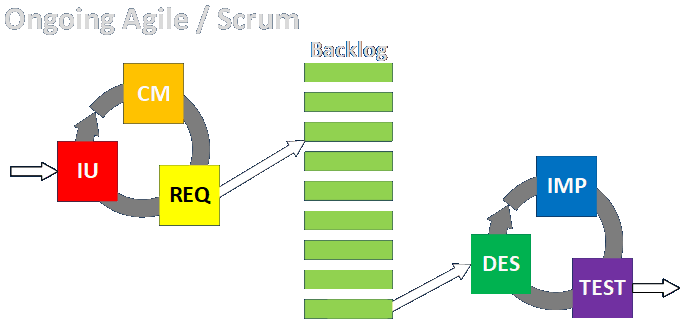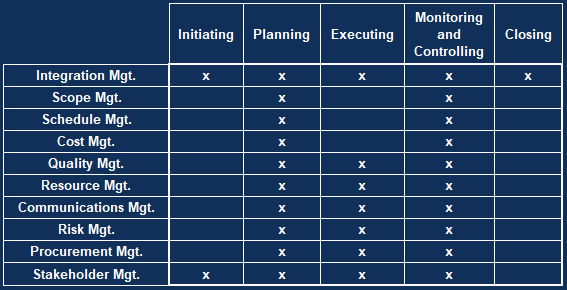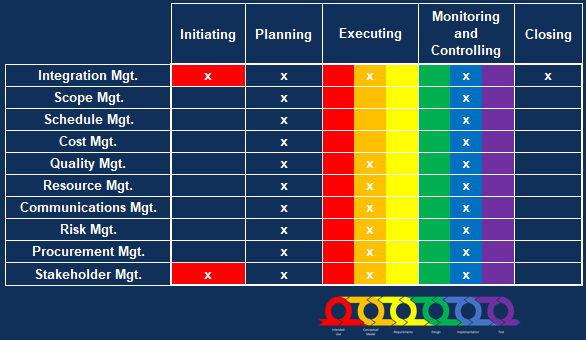I often describe the process of business analysis as being embedded in a process of project management. I’ve also described business analysis as an activity that takes place within a project management wrapper. Engagements (projects) may be run in many different styles, as shown below, but the mechanics of project management remain more or less the same.






What changes in the different regimes is the way the actual work gets done. And here I find it necessary to make yet another bifurcation. While I talk about business analysis as taking place across the entire engagement life cycle, through all of its phases, the function of the BA is different in each phase, and the level of effort is also different in each phase.
I think of essentially three groups as being involved in each engagement, the managers, the analysts, and the implementers (and testers). Let’s look at their duties and relative levels of participation across each of the phases. The descriptions are given as if every role was filled by different people with siloed skill sets, but individuals can clearly function in multiple roles simultaneously. I’ve done this in some instances and it will almost inevitably be the case in smaller teams and organizations.
- Intended Use (Problem Definition): This is where the project’s ultimate goals are defined, resources are procured, and governance structures are established. This work is primarily done by project and program managers, product owners and managers, and the sponsors and champions. Analysts, as learning and translating machines, can serve in this phase by understanding the full life cycle of an effort and how the initial definition and goals may be modified over time. It may be that only senior analysts participate in this phase. Implementers can contribute their knowledge of their methods and solution requirements and how they need to interact with customers.
- Conceptual Model: This is where the analysts shine and drive the work. The managers may need to facilitate the mechanics of the discovery and data collection processes, but the analysts will be the ones to carry it out, document their findings, and review them with the customers, making changes and corrections until all parties have reached agreement. The implementers will generally be informed about events, and may participate lightly in discovery activities or do brief site visits to get a feel for who they are serving and the overall context of the work.
- Requirements: This works very much like the conceptual model phase, where the analysts find out what the customers need through elicitation and review and feedback. The implementers will be a little more involved to the degree that their solutions inject their own requirements into the process. Managers facilitate the time, resources, introductions, and permissions for the other participants.
- Design: There are two aspects to the design. The abstract design may be developed primarily by the analysts, while the more concrete aspects of the design are likely to be developed by the implementers. I often describe the requirements phase as developing the abstract To-Be state and the design as developing the concrete To-Be state, but even the “concreteness” of the design has different levels. The abstract (but concrete!) part of the design describes the procedures, equations, data items, and outputs for the solution, while the concrete (really, really concrete!) part of the design specifies how the foregoing is implemented. I know from painful experience that you can have a really good idea what you need a system to do, but being able to implement your desires correctly and effectively can be difficult, indeed. See here, here, and here for further discussion. The latter item is especially germane.
- Implementation: The implementers clearly do most of the work here. The analysts serve as liaisons between the implementers and customers by facilitating ongoing communication, understanding, and correction. The managers support the process and the environment in which the work is conducted.
- Test (and Acceptance): The implementers (and testers) also expend most of the effort in this phase. The managers facilitate and protect the environment and verify final acceptance of all items. The analysts facilitate communication between all participants and the customer, and also continually attempt to improve the flow of the entire working process.
I tend to express the phases of my analysis framework in a streamlined form of a more involved process. I start with everything that gets done:
- Project Planning
- Intended Use
- Assumptions, Capabilities, and Risks and Impacts
- Conceptual Model (As-Is State)
- Data Sources, Collection, and Conditioning
- Requirements (To-Be State: Abstract)
- Functional (What it Does)
- Non-Functional (What it Is, plus Maintenance and Governance)
- Design (To-Be State: Detailed)
- Implementation
- Test
- Operation, Usability, and Outputs (Verification)
- Outputs and Fitness for Purpose(Validation)
- Acceptance (Accreditation)
- Project Close
- Operation and Maintenance
- End-of-Life and Replacement
Then I drop the management wrapping at the beginning and end (with the understanding that it not only remains but is an active participant through all phases of an engagement or project/product/system life cycle) simply because it’s not explicitly part of the business analysis oeuvre.
 Intended Use
Intended Use Conceptual Model (As-Is State)
Conceptual Model (As-Is State) Data Sources, Collection, and Conditioning
Data Sources, Collection, and Conditioning Requirements (To-Be State: Abstract)
Requirements (To-Be State: Abstract)- Functional (What it Does)
- Non-Functional (What it Is, plus Maintenance and Governance)
 Design (To-Be State: Detailed)
Design (To-Be State: Detailed) Implementation
Implementation Test
Test- Operation, Usability, and Outputs (Verification)
- Outputs and Fitness for Purpose (Validation)
 Operation and Maintenance
Operation and Maintenance End-of-Life and Replacement
End-of-Life and Replacement
Then we simplify even further, since the data melts into the other phases and we don’t always worry about the full life cycle.
Now let’s consider the practice of project management in its own language. The Project Management Body of Knowledge (PMBOK) is the Project Management’s Institute’s (PMI) analog to the IIBA’s BABOK. It defines five phases of a project as follows.

The figure above shows the five phases proceeding from left to right through the course of the project. The practice embodies management of ten different areas of concern, each of which comes into play during some or all of the project’s phases. (This was true through the sixth edition of the PMBOK. The recently released seventh edition replaces the ten knowledge areas with twelve principles, including extensive coverage of Agile practices. I will update this article accordingly at some point in the future.)
The project is defined and kicked off during the initiating phase, during which the requisite stakeholders are identified and involved. The project charter is developed in this phase, shown in the integration management area in the upper left. BAs can definitely be part of the process of creating and negotiating the charter and helping to shape the project and its environment. The project charter defines the key goals of the project, the major players, and something about the process and environment.
The planning phase is where the bulk of the preparation gets done in terms of establishing the necessary aspects of the working environment and methodologies for the project. The actual work gets done in the executing phase, with the monitoring and controlling phase proceeding concurrently, but which is devoted to monitoring, feedback, and correction separate from the actual work. The closing phase ends the project, records lessons learned, archives relevant materials, celebrates its successes (hopefully…), and releases resource for other uses. The methods and concerns in each of the ten management areas all overlap with the practice of business analysis, and BAs should absolutely be involved with that work.
In the figure below I show that, once the engagement (or effort or project or venture or whatever) is set up, most of the work of the business analysis (as well as the implementation and testing) oeuvre is accomplished during the executing phase and the monitoring and controlling phase. This includes the intended use phase (which also includes the activities in the project charter), because it may change as the result of developments, discovery, and feedback over the course of the engagement.
Don’t take the location of the phases too literally. I’m not saying the first three BA phases occur during executing and the remaining three during monitoring and controlling. Rather, I’m saying that all phases of BA work are conducted during the concurrent executing and monitoring and controlling phases. Seen in this light, The initiating, planning, and closing phases from the project management oeuvre are the “wrapper” within which the bulk of an engagement’s actual work is done.

I’ll end by emphasizing a few things again. These general concepts apply no matter what project approach may be taken (e.g., Waterfall, Agile, Scrum, Kanban, SAFe, or hybrid). Individuals may wear multiple hats depending on the organization and situation. All parties should work together to bring their strengths and unique abilities together. Few participants are likely to participate through all phases of an engagement, but they should be made aware of the full context of their work. Greater understanding of the roles of all participants and job functions will greatly aid cooperation and understanding. And finally, and most importantly, that greater understanding will lead to greater success!
